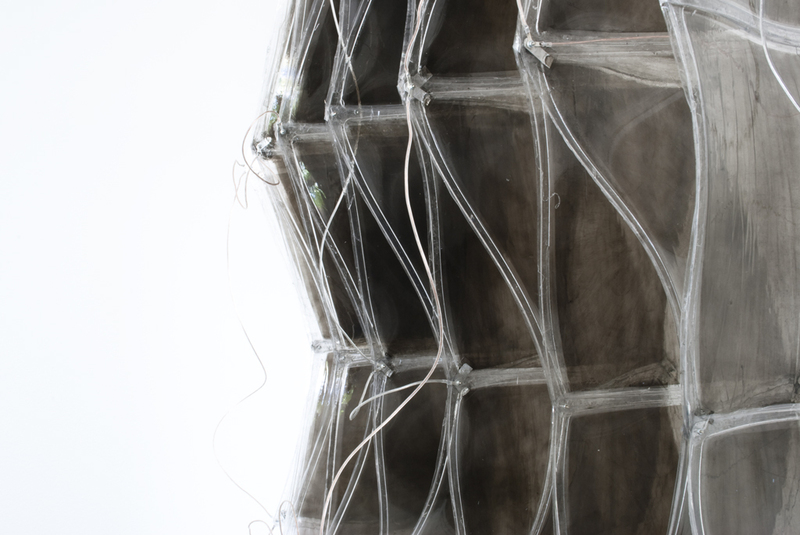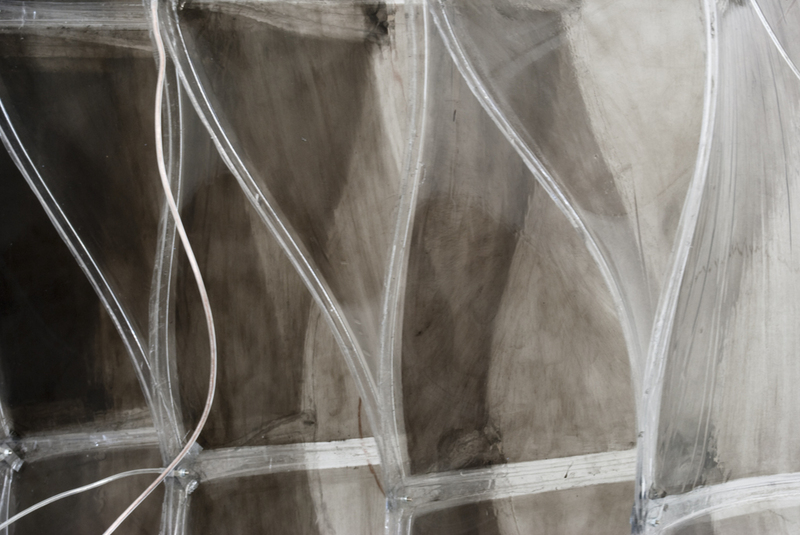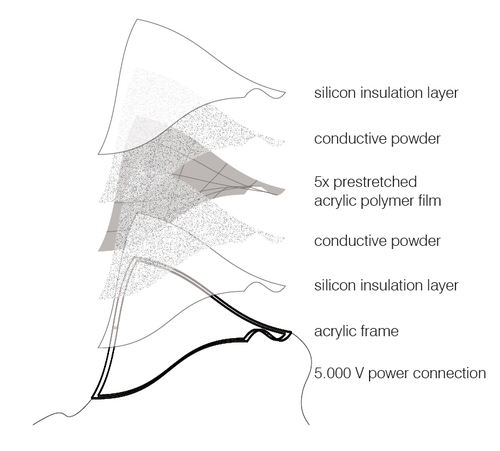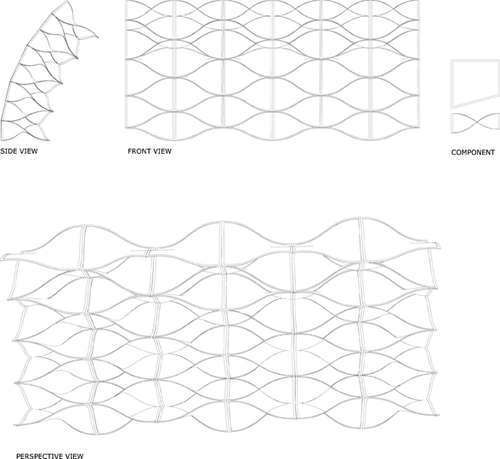
EAP is a polymer actuator that converts electrical power into kinetic force. Due to its extreme flexibility, lightness, transparency, thin dimensions and its ability to smoothly change shape it is a highly attractive component for architectural solutions.
ShapeShift
By Manuel Kretzer and Edyta Augustynowicz and Sofia Georgakopulou and Dino Rossi and Stefanie Sixt

The component based form results from the material’s desire to return into its original shape combined with specially designed structural frames developed to allow an appropriate degree of flexibility.

Through direct component-to-component linkages an added layer of complexity is achieved. Each entity has an influence on the form and movement of its neighbors, and therefore, on the structure as a whole.

EAP working principle: After application of high voltage the elastomeric film is compressed and expands in area.

Different layers of membrane components (from top to bottom: silicon insulation, conductive powder, pre-stretched polymer film, conductive powder, silicon layer, acrylic frame, 5 kV power connection)

Early investigations focused on static supporting structures, but after a number of experiments, the interest moved towards developing dynamic structural configurations. In these dynamic systems no static backbones are necessary, rather, individual components are connected to each other to produce self-supporting forms.























13581 Comments – Login to comment
fdfddfdfsddsds · Nov 8, 22 9:41 pm
It is my first visit to your blog, and I am very impressed with the articles that you serve. Give adequate knowledge for me. Thank you for sharing useful material. I will be back for the more great post. But by chance looking at your post solved my problem! I will leave my blog, so when would you like to visit it?!https://casinonation.org/
prestigeprimro9 · Nov 11, 22 11:33 pm
Prestige Primrose Hills brand new residential condos owned by prestige groups developed at Banashankari south bangalore near by kanakapura road.https://www.prestigeprimrosehills.gen.in
fdfddfdfsddsds · Nov 12, 22 1:44 am
What a post I've been looking for! I'm very happy to finally read this post. Thank you very much. Can I refer to your post on my website? Your post touched me a lot and helped me a lot. If you have any questions, please visit my site and read what kind of posts I am posting. I am sure it will be interesting.https://majorcasino.org/
stefan012baker · Nov 18, 22 4:19 am
I am happy that you started this blog because I am always looking for high-quality articles, and your blog has them.billeyfarnendis · Nov 18, 22 5:01 am
Visit: https://mnsmarketgroup.com/blog/workforce-management-vs-monday-crm-software
purvacodenameserene · Nov 18, 22 7:12 am
Purva Codename Serene is a neoteric home design in Chennai South's Pallikaranai. Puravankara Limited's experience includes exquisitely designed 1, 2, and 3 BHK luxury residences. The design provides luxurious living amid ultramodern facilities and greenery outdoors. This is the most sought-after real-estate hub in Chennai City. The location provides excellent connection and proximity for convenient dining. Then there are a lot of brief facts about Whitefield that make it one of Bangalore's most unspoken domestic accords.Visit: https://purva-codenameserene.in/
johnyki79579551 · Nov 19, 22 1:25 am
Wow! Such an amazing and helpful post this is. I really really love it. It's so good and so awesome. I am just amazed. I hope that you continue to do your work like this in the future also Satta kingfdfddfdfsddsds · Nov 30, 22 1:34 am
I'm so happy to finally find a post with what I want. You have inspired me a lot. If you are satisfied, please visit my website and leave your feedback.https://majorcasino.org/
prestigesanctuary · Dec 1, 22 3:40 pm
fdfddfdfsddsds · Dec 4, 22 10:29 pm
What a post I've been looking for! I'm very happy to finally read this post. Thank you very much. Can I refer to your post on my website? Your post touched me a lot and helped me a lot. If you have any questions, please visit my site and read what kind of posts I am posting. I am sure it will be interesting.https://majorcasino.org/
vânavvvnhpham · Dec 5, 22 4:23 am
I finally found what I was looking for! I'm so happy. https://evo-casino24.com/ Your article is what I've been looking for for a long time. I'm happy to find you like this. Could you visit my website if you have time? I'm sure you'll find a post of interest that you'll find interesting.taurusarmstore · Dec 5, 22 5:07 am
taurusarmstore · Dec 5, 22 5:07 am
brigadeoasis2 · Dec 5, 22 6:40 am
Bangalore cities brand new residential plotted community project Brigade Oasis for ready to launch in the location Devanahalli Bangalore surrounding north places. This location was in high demand in real estate projects growing in recent times and this project invests high to buyers daily.
bein247 · Dec 5, 22 6:46 am
YouTube">https://ytmp4converter.com/en/">YouTube to MP4 YTMP4 Converter or YTMP4 is a free online tool to convert and download YouTube videos to MP3 & MP4 files without registration.vânavvvnhpham · Dec 10, 22 1:40 am
Hello, I am one of the most impressed people in your article.https://evo-casino24.com/ I'm very curious about how you write such a good article. Are you an expert on this subject? I think so. Thank you again for allowing me to read these posts, and have a nice day today. Thank you.josiahnepomuceno · Dec 12, 22 7:45 am
I love this article.. thank you for the information. check this outhttps://www.acepoolbuilders.com/pool-renovationschenyeong · Dec 13, 22 6:55 am
dominicferrar · Dec 21, 22 9:01 am
Very informative article! https://www.thetarpco.com/hobbsjohnson · Dec 28, 22 5:39 am
Seizures | Narcolepsy | Atypical Antipsychotics Drugs Information | Peripherally Acting Antiobesity Agents | Narcotic Analgesic Combinations | Pain management | CNS Stimulants | Weight-Loss | phentermine pills where can i get phentermine to lose weight phentermine diet pills phentermine online online doctors who prescribe phentermine phentermine weight loss pills phentermine near me buy phentermine online buy phentermine where to buy phentermine phentermine prescription adipex near me buy adipex p 37.5 mg buy adipex adipex online buy adipex online Buy Xanax Online Buy Ambien Online Buy Adderall Online buy tramadol online phentermine pills buy tramadol online buy tramadol tramadol online buying tramadol online tramadol buy online tramadol for sale order tramadol online buy oxycodone online oxycodone for sale buy oxycodone oxycodone online order oxycodone online legally buy oxycodone without prescription oxycodone no prescription order oxycodone online oxycodone buy oxycodone buy onlinePersonal Loans for Bad credit Loans for Bad credit Online Loans for Bad credit Loans for people with bad credit Bad Credit Loans Personal Car Loans for Bad credit Bad Credit Loans No check credit loan Installment Loans for Bad credit Loans for Bad Credit Online Loans for Bad credit Auto Loans for Bad credit Urgent Loans for Bad credit Small Loans for Bad credit Home Loans for Bad credit Bad Credit Loans Personal Buy Hydrocodone Online Buy Hydrocodone Hydrocodone Online Hydrocodone For Sale How To Get Hydrocodone Order Hydrocodone Online Hydrocodone Without Prescriptions Buying Hydrocodone online Where To Buy Hydrocodone Buy Hydrocodone Without Prescription Order Hydrocodone Somas Pills Buy Soma Online Soma Online Buying Soma Buy Somas Online Cheap Generic Soma Pill Buy Soma Buying Carisoprodol Online Buy Somas Online Next Day Delivery Buy Watson Carisoprodol 350 mg Order Soma Online Purchase Soma Online No Prior Prescription Personal Loans for Bad credit Loans for Bad credit Online Loans for Bad credit Loans for people with bad credit Bad Credit Loans Personal Car Loans for Bad credit Bad Credit Loans No check credit loan Installment Loans for Bad credit Loans for Bad Credit Online Auto Loans for Bad credit Urgent Loans for Bad credit Small Loans for Bad credit Home Loans for Bad credit Bad Credit Loans Personal | Web Design Company | Website Design Company | Digital Marketing Agency | SEO Company
adamkowal · Dec 30, 22 1:43 am
https://www.followersleader.com/product/buy-instagram-followers/ https://www.mrfollower.fr/produit/acheter-des-followers-instagram/ https://www.comprarefollower.it/prodotto/comprare-follower-instagram/ https://www.senhorseguidor.com/produto/comprar-seguidores-no-instagram/ https://www.senorseguidor.es/producto/comprar-seguidores-instagram/ https://www.echtefollower.de/produkt/instagram-follower/ https://www.followersy.pl/produkt/instagram-obserwujacy/ https://fameboosters.pl/ https://www.kupobserwujacych.pl/produkt/instagram-follow/ https://www.echtefollower.de/produkt/tiktok-follower-kaufen/fdfddfdfsddsds · Dec 30, 22 11:08 pm
I’m not sure exactly why but this weblog is loading incredibly slow for me. Is anyone else having this problem or is it a problem on my end? I’ll check back later on and see if the problem still exists. https://casinosite.asia/tranchang · Jan 11, 23 11:00 pm
pnet · Jan 18, 23 2:45 am
hotelwaliservices · Feb 6, 23 12:49 am
Thanks for posting such an informative article, thanks for sharing informative posthttp://www.hotelwali.net/
https://clicklute.com/call-girls/jaipur/1269515
http://www.hotelwali.net/mumbai/marol-escorts-service/
http://www.hotelwali.net/mumbai/lonavala-escorts-service/
http://www.hotelwali.net/mumbai/jogeshwari-escorts-service/
http://www.hotelwali.net/mumbai/mahim-escorts-service/
https://clicklute.com/call-girls/kozikode/15000129
https://clicklute.com/call-girls/delhi/1273294
https://clicklute.com/call-girls/nerul/15000156
https://clicklute.com/call-girls/gwalior/15000088
acedata · Feb 10, 23 6:06 am
AceData offers data protection services, including data backup and recovery, archiving, disaster recovery, and tape recovery services. Our Cloud Backup Recovery services are designed for every industry and for all sizes of business.Cloud Backup Recovery|
Backup data|
Data backup|
Microsoft Backup|
Cloud backup pricing|
Cloud backup for healthcare|
Continuous data protection|
Data Protection|
grepdigital · Feb 10, 23 8:32 am
Grep Digital provides speedy execution of Digital Initiatives by leveraging the world's first Fractal Service platform that helps customers rapidly rollout technology initiatives.
We do this by providing on-demand expertise curated from an ecosystem of niche technical teams, subject matter experts and reusable technology assets.
Visit us on:
Fractal Services
Fractal Services Platform
Digital transformation
Product Incubation
build operate transfer
build operate transfer model
onestopglobal · Feb 10, 23 10:39 am
Gatepass software by OneStop is a software designed to manage the entry and exit of people, vehicles, and assets in a secure and organized manner.visitor management system
Visitor Gate Pass
GatePass
Gate Pass
enertiaco · Feb 10, 23 11:58 am
Facade lighting refers to the practice of illuminating the exterior of a building. This can be done for both functional and aesthetic purposes, providing visibility and enhancing the appearance of the building.facade lighting
led facade lighting
rgb lighting
home automation
facade lighting design
mandiripinjamandana · Feb 11, 23 7:19 am
mandiripinjamandana · Feb 11, 23 7:22 am
rajanranjan · Feb 16, 23 3:21 am
The well-designed property at https://thelodhagroups.in/hinjewadi/"> Lodha Hinjewadi is a New-Launch residential luxury segment by the Lodha Group.offers luxurious 2BHK and 3BHK apartments.
rajanranjan · Feb 16, 23 3:22 am
rajanranjan · Feb 16, 23 3:23 am
The well-designed property at Lodha Project Hinjewadi offers luxurious 2BHK and 3BHK apartments.https://thelodhagroups.in/hinjewadi/price/
rajanranjan · Feb 16, 23 3:26 am
Lodha Hinjewadi by Lodha Group. It offers luxury apartments with world class amenities. Get in touch for Lodha Hinjewadi.https://lodhahinjewadi.blogspot.com/2023/02/affordable-residential-flats-for-sale.html https://lodhahinjewadipune.medium.com/best-advantages-of-living-in-an-apartment-pune-206487afb36f https://www.reddit.com/r/Lodha_Hinjewadi_Pune/comments/10zknij/affordable_residential_luxury_apartme... https://lodhahinjewadi.quora.com/?invite_code=3WrOGEmllg2u4u5hVRAz https://qr.ae/prbscq
mudasirsaleem1 · Feb 22, 23 2:20 pm
HQ Backlink https://cpmseo.com/edu-gov-links/ I’ve read some good stuff here. Definitely worth bookmarking for revisiting. I surprise how much effort you put to create such a great informative website.nikkibella1 · Feb 23, 23 8:22 am
Find out the Brother printer IP address by pressing 'Menu' and going to the 'WLAN' tab. Choose 'WLAN Status' followed by 'Infrastructure Mode.' You will find the network connection settings. The IP address of your Brother printer will be there on the third line. If it is 0.0.0.0, the printer isn't linked to the network.
https://www.printerfixingerror.com/blog/brother-printer-ip-address/
godrejsplendour1111 · Mar 3, 23 5:16 am
Godrej Properties high-end residential development, Godrej Splendour, is situated in Bangalore. The property offers opulent 1, 2, and 3 BHK apartments that are furnished with a variety of contemporary amenities, making it a popular option for those looking for a convenient living. https://www.godrejsplendour.net.in/godrejsplendour11111 · Mar 7, 23 2:26 am
Godrej Splendour is a luxury high-rise apartment project coming up in the heart of , Whitefield, Bangalore East, Belathur Road.https://www.godrejsplendour.org.in
providentdeensgate · Mar 10, 23 7:43 am
Provident Deens Gate is a futuristic residential project developing in the best area IVC Road, Bangalore. This project offers modern apartment houses of single, double and triple bedroom houses with modern amenities. This project is the best option for the people who are looking for modern houses. This project is being developed by the Provident Housing. https://www.providentdeensgate.in/providentdeensgate · Mar 10, 23 7:46 am
Provident Deens Gate is a futuristic residential project developing in the best area IVC Road, Bangalore. This project offers modern apartment houses of single, double and triple bedroom houses with modern amenities. This project is the best option for the people who are looking for modern houses. This project is being developed by the Provident Housing. https://www.providentdeensgate.in/vickykaushal · Mar 11, 23 12:48 pm
Thanks for your personal marvelous posting!
I actually enjoyed reading it, you could be a great author. Follow Us To Find Out More! Wpc15 Online Sabong Register
godrejsplendourproject · Mar 17, 23 10:39 pm
Provident">https://www.providentecopoliten.in">Provident Ecopoliten is the massive new luxury-themed residential Apartment project launched in Aerospace park at Bagalur, North Bangalore.prestigesouthernstar · Mar 24, 23 5:01 am
I completely agree with your viewpoint on this subject. It's refreshing to see someone presenting a well-reasoned argument in favor of it.https://www.prestigesouthernstar.info/
prestigesouthernstar · Mar 24, 23 5:02 am
prestigesouthernstar · Mar 24, 23 5:03 am
brigadevalencia1 · Mar 24, 23 10:36 pm
Great article! I found your perspective on the topic very insightful and thought-provoking. Thanks for sharing your thoughts.https://www.brigadevalencia.net.in/prestigepark · Mar 25, 23 12:19 am
Such a nice content. Really enjoyed this article.https://www.prestigeparksgrove.ind.in
prestigeserenityshores111 · Mar 25, 23 1:29 am
Enjoyed your narration.My new business https://www.prestigeserenityshore.in
godrejsplendou4 · Mar 25, 23 2:05 am
Very helpful and insightful article.https://www.godrejsplendour.net.in